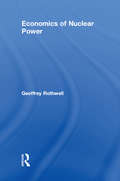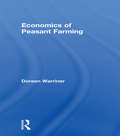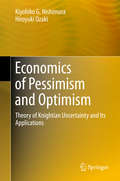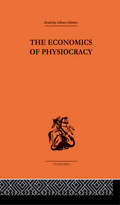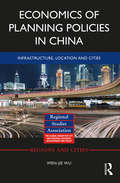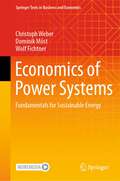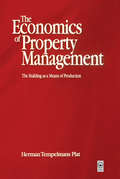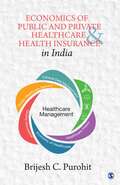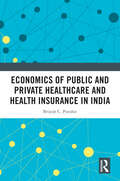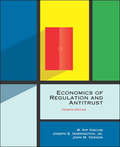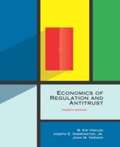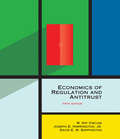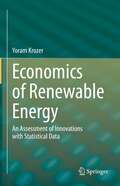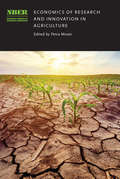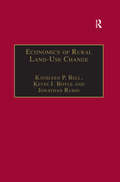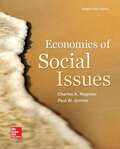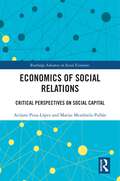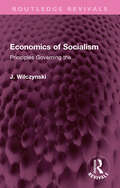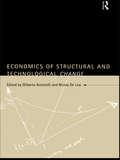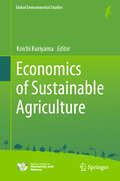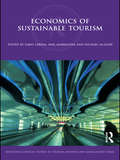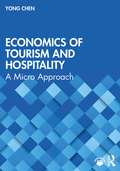- Table View
- List View
Economics of Nuclear Power
by Geoffrey RothwellThis book is a unique introduction to the economic costs of nuclear power. It examines the future of the nuclear power industry and unpacks the complicated relationships between its technical, economic and political variables. It does so by modelling the costs, risks and uncertainties of one of the world’s most opaque industries using micro-econometrics, econometrics, and cost engineering. Economics of Nuclear Power examines the very important costs of externalities (storing of nuclear waste and the impact of a Chernobyl or Fukushima event) and compares those to the externalities of alternative carbon based energies (oil, coal, natural gas). With over 100 tables and figures this book details nuclear power production around the world - present and planned, providing a completely global focus. It also includes an overview of the past 70 years of international nuclear power developments. This book is essential reading for students, scholars and professionals interested in energy economics, nuclear engineering and energy policy.
Economics of Peasant Farming
by Doreen WarrinerThis book, first published in 1939, was originally conceived as an investigation of peasant farming in Europe written in the years of the agricultural depression of the nineteen-thirties. It shows an immense contrast between the well-capitalized commercial peasant farming of Western Europe and the poor subsistence farming of the remotest parts of Eastern Europe; and between these two extremes a wide range of variation in standards of living and farming efficiency.
Economics of Pessimism and Optimism
by Kiyohiko G. Nishimura Hiroyuki OzakiThis is the first book to investigate individual's pessimistic and optimistic prospects for the future and their economic consequences based on sound mathematical foundations. The book focuses on fundamental uncertainty called Knightian uncertainty, where the probability distribution governing uncertainty is unknown, and it provides the reader with methods to formulate how pessimism and optimism act in an economy in a strict and unified way. After presenting decision-theoretic foundations for prudent behaviors under Knightian uncertainty, the book applies these ideas to economic models that include portfolio inertia, indeterminacy of equilibria in the Arrow-Debreu economy and in a stochastic overlapping-generations economy, learning, dynamic asset-pricing models, search, real options, and liquidity preferences. The book then proceeds to characterizations of pessimistic (ε-fearful) and optimistic (ε-hopeful) behaviors under Knightian uncertainty and people's inherent pessimism (surprise aversion) and optimism (surprise loving). Those characterizations are shown to be useful in understanding several observed behaviors in the global financial crisis and in its aftermath. The book is highly recommended not only to researchers who wish to understand the mechanism of how pessimism and optimism affect economic phenomena, but also to policy makers contemplating effective economic policies whose success delicately hinges upon people's mindsets in the market.
Economics of Physiocracy: Essays And Translations (Routledge Library Editions)
by Ronald L. MeekThe birth of Physiocracy was the birth of the science of economics in the broad general form in which it is known to us today. It is surprising therefore that the Physiocrats should have received so little attention from economists in the English-speaking world. This book fills that gap.The volume begins with a deliberately non-specialist introduction. Translations of Physiocratic writings then follow and the final section of the book consists of specialized essays, dealing with certain aspects of the Physiocratic doctrine, its history and its influence.
Economics of Planning Policies in China: Infrastructure, Location and Cities (Regions and Cities)
by Wen-jie WuFast urbanizing countries like China have experienced rapid – albeit geographically uneven – local and regional economic growth during the past few decades. Notwithstanding this development pattern, China has been investing heavily in targeted coastal and inland regions through planning policies for infrastructure, location and cities. This is a largely place-based investment process that is of great importance for the public, business and policymakers. China’s urban and regional transformations provide incentives for spatial agglomeration and will shift the growth of activities within and across cities for decades to come. This spatial differentiation is likely to be driven by government decisions at all levels about where, when and in what to invest, in an institutional context where policy instruments act to constrain or facilitate China’s urban and regional development. Economics of Planning Policies in China looks at the role that the institutional characteristics of the Chinese planning system and market mechanisms play in transforming and shaping the infrastructure, location and cities with the potential for spatial disparity and inclusive growth. The planning and geographical perspective and evidence make this book a reference for international scholars, policymakers and graduates
Economics of Power Systems (International Series in Operations Research & Management Science #327)
by Antonio J. Conejo Afzal S. Siddiqui Makoto TanakaThis book describes the latest microeconomic concepts and operations research (OR) techniques needed to comprehend the design and operation of power markets, as well as the actions of their agents: producers, consumers, operators, and regulators. This is critical when it comes to addressing a constantly evolving power system environment that incorporates an increasing number of no-marginal-cost renewable sources, increasingly competitive storage facilities, increasingly responsive demands, and widespread communication channels that allow distributed decision-making. Such evolving environments call for a re-examination of the microeconomic concepts and OR techniques required by graduate students and practitioners in the electric energy field. This accessible, tutorial-style book features numerous illustrative examples to help readers grasp the economic concepts and OR procedures used by power market professionals. The authors explian these concepts and procedures and present a vision of a renewable-dominated marketplace. Each chapter also includes exercises.
Economics of Power Systems: Fundamentals for Sustainable Energy (Springer Texts in Business and Economics)
by Christoph Weber Wolf Fichtner Dominik MöstIn order to manage the transition towards a sustainable future electricity system, an in-depth understanding of the key technological, economic, environmental and societal drivers for electricity markets is required. Suitable for advanced undergraduate and graduate students, this textbook provides an overview of these drivers and introduces readers to major economic models and empirical evidence for the study of electricity markets and systems. Readers will learn about electricity generation, demand, transport, and storage, as well as the fundamentals of grid and electricity markets in Europe. By introducing them to state-of-the-art models from operations research and economics, the book provides a solid basis for analytical insights and numerical modeling. Furthermore, the book discusses the policy instruments and design choices for electricity market regulation and sustainable power system development, as well as the current challenges for smart energy systems.
Economics of Property Management: The Building As A Means Of Production
by Herman Tempelmans Plat Frank HeynickThe economic analysis of a building is a complex subject and traditionally it has focused on a single aspect of the structure or a single part of the construction process. Dr Tempelmans Plat is a leading proponent of a new methodology which focuses on the building as a stock of services to be supplied over a long lifespan. This method is more realistic since it takes into account the changes in use and the adaptation of the building over its life. This book will be the first to make this method comprehensible to a wide audience of postgraduate students and professionals in the field of construction economics.
Economics of Public and Private Healthcare and Health Insurance in India
by Brijesh C. PurohitWith its focus on the planned universal healthcare coverage in India, Economics of Public and Private Healthcare and Health Insurance in India presents an exhaustive account of both the public healthcare system and the private healthcare market. It explores the shortcomings that prevent the common citizen from trusting either of them completely. The book provides a critical analysis of the various health insurance providers and their different products. It also lays out how those without insurance are exploited by the healthcare system. Further, it covers the various existing and potential health insurance markets in India. Despite several centrally sponsored health insurance schemes as well as those sponsored by all major Indian states, the healthcare coverage of common Indian citizens is abysmally low. The policy inputs from this book will help reorient the thinking of both central and state level policymakers towards making healthcare a priority area. This will go a long way in making India a forerunner among South Asian countries in their efforts to provide optimal healthcare to all their citizens.
Economics of Public and Private Healthcare and Health Insurance in India
by Brijesh C. PurohitThis book critically examines the public and private healthcare systems in India. Analysing the current scenario of health insurance in India, it studies the inadequacy of public healthcare services and unaffordability of private health care facilities. The volume investigates government sponsored health insurance schemes and advocates for the need of universal health insurance coverage. It details India’s per capita health expenditure and provides policy inputs on how healthcare systems and insurance coverage can be improved in the country. Further, it explores the financial parameters of health insurers and standalone private health insurance companies, and also discusses the adverse impact of the Covid-19 pandemic on Indian healthcare. An insightful read on the state of healthcare in India, this book will be of interest to researchers and academics working in the fields of insurance, healthcare administration and management, public health policy and practice, health and social care, medical sociology, and sociology & social policy. It will also be useful for think tanks and policy makers.
Economics of Regulation and Antitrust
by W. Kip Viscusi Joseph E. Harrington John M. VernonA substantially revised and updated new edition of the leading text on business and government, with new material reflecting recent theoretical and methodological advances; includes further coverage of the Microsoft antitrust case, the deregulation of telecommunications and electric power, and new environmental regulations. This new edition of the leading text on business and government focuses on the insights economic reasoning can provide in analyzing regulatory and antitrust issues. Departing from the traditional emphasis on institutions, Economics of Regulation and Antitrust asks how economic theory and empirical analyses can illuminate the character of market operation and the role for government action and brings new developments in theory and empirical methodology to bear on these questions.The fourth edition has been substantially revised and updated throughout, with new material added and extended discussion of many topics. Part I, on antitrust, has been given a major revision to reflect advances in economic theory and recent antitrust cases, including the case against Microsoft and the Supreme Court's Kodak decision. Part II, on economic regulation, updates its treatment of the restructuring and deregulation of the telecommunications and electric power industries, and includes an analysis of what went wrong in the California energy market in 2000 and 2001. Part III, on social regulation, now includes increased discussion of risk-risk analysis and extensive changes to its discussion of environmental regulation. The many case studies included provide students not only pertinent insights for today but also the economic tools to analyze the implications of regulations and antitrust policies in the future. The book is suitable for use in a wide range of courses in business, law, and public policy, for undergraduates as well at the graduate level. The structure of the book allows instructors to combine the chapters in various ways according to their needs. Presentation of more advanced material is self-contained. Each chapter concludes with questions and problems.
Economics of Regulation and Antitrust (4th edition)
by W. Kip Viscusi Joseph E. Harrington John M. VernonThis new edition of the leading text on business and government focuses on the insights economic reasoning can provide in analyzing regulatory and antitrust issues. Departing from the traditional emphasis on institutions, Economics of Regulation and Antitrust tasks how economic theory and empirical analysis can illuminate the character of market operation and the role for government action and brings new developments in theory and empirical methodology to bear on these questions. The fourth edition has been substantially revised and updated throughout, with new material added and extended discussion of many topics. Part I, on antitrust, has been given a major revision to reflect advances in economic theory and recent antitrust cases, including the case against Microsoft and the Supreme Court's Kodak decision. Part II, on economic regulation, updates its treatment of the restructuring and deregulation of the telecommunications and electric power industries, and includes an analysis of what went wrong in the California energy market in 2000 and 2001. Part III, on social regulation, now includes increased discussion of risk-risk analysis and extensive changes to its discussion of environmental regulation. The many case studies included provide students not only pertinent insights for today but also the economic tools to analyze the implications of regulations and antitrust policies in the future. The book is suitable for use in a wide range of courses in business, law, and public policy, for undergraduates as well at the graduate level. The structure of the book allows instructors to combine the chapters in various ways according to their needs. Presentation of more advanced material is self-contained. Each chapter concludes with questions and problems.
Economics of Regulation and Antitrust, fifth edition (The\mit Press Ser. #Vol. 4)
by W. Kip Viscusi Joseph E. Harrington David E. SappingtonA thoroughly revised and updated edition of the leading textbook on government and business policy, presenting the key principles underlying sound regulatory and antitrust policy.Regulation and antitrust are key elements of government policy. This new edition of the leading textbook on government and business policy explains how the latest theoretical and empirical economic tools can be employed to analyze pressing regulatory and antitrust issues. The book departs from the common emphasis on institutions, focusing instead on the relevant underlying economic issues, using state-of-the-art analysis to assess the appropriate design of regulatory and antitrust policy. Extensive case studies illustrate fundamental principles and provide insight on key issues in regulation and antitrust policy. This fifth edition has been thoroughly revised and updated, reflecting both the latest developments in economic analysis and recent economic events. The text examines regulatory practices through the end of the Obama and beginning of the Trump administrations. New material includes coverage of global competition and the activities of the European Commission; recent mergers, including Comcast-NBC Universal; antitrust in the new economy, including investigations into Microsoft and Google; the financial crisis of 2007–2008 and the Dodd-Frank Act; the FDA approval process; climate change policies; and behavioral economics as a tool for designing regulatory strategies.
Economics of Renewable Energy: An Assessment of Innovations with Statistical Data
by Yoram KrozerThe book provides a comprehensive review of renewable energy from an economic perspective throughout the last two hundred years, starting from traditional renewable energy based on bio and hydro energy. The focus is on modern renewable energy based on geothermal, wind, and solar energy. It emerged when innovative entrepreneurs captured opportunities for valuable energy services. As the services with renewable energy expanded, the costs of technologies decreased entailing global commercialisation. This enables larger access to energy and emission reduction of carbon dioxide, but also causes larger differences in the energy resources across countries which impedes international policies. That optimistic viewpoint on the shift to the global low-carbon economy is largely based on statistical data about purchasing power, energy consumption and businesses, and valuable energy services in many countries on all continents. The data are presented in 70 tables, graphs, and figures, most of them original. Interpretation of the data are useful in support of decisions making about sustainable development in civil society, businesses, and policy makers as well as for the verifications of scholarly hypotheses and projections in energy and climate policies.
Economics of Research and Innovation in Agriculture (National Bureau of Economic Research Conference Report)
by Petra MoserFeeding the world’s growing population is a critical policy challenge for the twenty-first century. With constraints on water, arable land, and other natural resources, agricultural innovation is a promising path to meeting the nutrient needs for future generations. At the same time, potential increases in the variability of the world’s climate may intensify the need for developing new crops that can tolerate extreme weather. Despite the key role for scientific breakthroughs, there is an active discussion on the returns to public and private spending in agricultural R&D, and many of the world’s wealthier countries have scaled back the share of GDP that they devote to agricultural R&D. Dwindling public support leaves universities, which historically have been a major source of agricultural innovation, increasingly dependent on industry funding, with uncertain effects on the nature and direction of agricultural research. All of these factors create an urgent need for systematic empirical evidence on the forces that drive research and innovation in agriculture. This book aims to provide such evidence through economic analyses of the sources of agricultural innovation, the challenges of measuring agricultural productivity, the role of universities and their interactions with industry, and emerging mechanisms that can fund agricultural R&D.
Economics of Research and Innovation in Agriculture (National Bureau of Economic Research Conference Report)
by Petra MoserFeeding the world’s growing population is a critical policy challenge for the twenty-first century. With constraints on water, arable land, and other natural resources, agricultural innovation is a promising path to meeting the nutrient needs for future generations. At the same time, potential increases in the variability of the world’s climate may intensify the need for developing new crops that can tolerate extreme weather. Despite the key role for scientific breakthroughs, there is an active discussion on the returns to public and private spending in agricultural R&D, and many of the world’s wealthier countries have scaled back the share of GDP that they devote to agricultural R&D. Dwindling public support leaves universities, which historically have been a major source of agricultural innovation, increasingly dependent on industry funding, with uncertain effects on the nature and direction of agricultural research. All of these factors create an urgent need for systematic empirical evidence on the forces that drive research and innovation in agriculture. This book aims to provide such evidence through economic analyses of the sources of agricultural innovation, the challenges of measuring agricultural productivity, the role of universities and their interactions with industry, and emerging mechanisms that can fund agricultural R&D.
Economics of Rural Land-Use Change (Ashgate Studies in Environmental and Natural Resource Economics)
by Kevin J. BoylePublic concern over land management has never been greater. This book provides a broad overview of the economics of rural land-use change, drawing attention to the meaningful role economic analysis can play in resolving public concern and supporting future, pro-active land management strategies in rural areas. The book's breadth distinguishes it from other recent texts, as it jointly offers rigorous treatments of theoretical and empirical models of rural land-use change and practical discussions of applications and relevant methods. Chapters are specifically designed to demonstrate the types of land-use questions economic analysis can answer, the types of methods that might be employed to answer these questions, and the types of public policy decisions that may be supported by such analysis. The book makes a significant contribution to contemporary land-use research, highlighting the key methodological and public policy issues that will be central to future research on the economics of rural land-use change.
Economics of Social Issues (The Mcgraw-hill Series in Economics)
by Paul Grimes Charles Register Ansel SharpSharp, Register, and Grimes' Economics of Social Issues originated the social issues approach to teaching basic economic principles and has garnered a loyal user following for its timely and impartial handling of current social issues that dominate the news. The primary objectives of the book are to create student interest in the study of economics and provide a framework of basic analytical tools useful in the understanding of social issues. This edition provides fresh perspectives on current societal trends and public debates to stimulate classroom discussion and help students learn the important basic principles of economics. Each chapter presents economic concepts then places them within the context of current issues facing society.
Economics of Social Relations: Critical Perspectives on Social Capital (Routledge Advances in Social Economics)
by Atilano Pena-López Matías Membiela-PollánStarting from the idea that economic relations are social relations, and every economic fact is first a social fact, this book explores one of the crucial problems within economic science: how to embody the social dimension into the study of economic reality from a critical perspective.This book opens with an examination of the concept of social capital, incorporating all the approaches from the last 30 years of analysis. It reviews the two main orientations of existing research programmes in social capital: the macro or culturalist perspective and the micro or individual social capital. Furthermore, it proposes a reconstruction of the theory from a micro perspective. Finally, taking this approach, this book explores the link between social capital and the negative aspects of social reality, such as corruption or inequality, and, through the study of so-called relational goods, the influence of social capital on subjective well-being. The analysis of the concept of social capital not only involves economists but also requires a necessary bridge with sociology, anthropology, political science, and even psychology.This book will, therefore, be crucial reading for anyone engaged in the problem of the interrelation between economy and society.
Economics of Socialism: Principles Governing the... (Routledge Revivals)
by J. WilczynskiFirst published in 1970, Economics of Socialism covers all aspects of socialist economics: planning, profit, production and growth, investment, consumption, labor and land. The author then goes on to discuss pricing, money and banking, fiscal policy and control, and both domestic and foreign trade and international economic cooperation. The book is introduced by a background chapter on the socialist economic system, models of the socialist economy, the reforms, and the new socialist economics. It ends with a singularly objective comparison of socialist and capitalist economies and seeks to answer the question of whether the two systems are indeed converging.The book is based on socialist sources published in the Eastern European countries, which Professor Wilczynski has studied in the original, and which he is able to interpret against a first-hand knowledge of the countries concerned. He also provides a considerable apparatus which will be useful to students: a full glossary of socialist economic terms and extensive references for further reading in English. This is an interesting historical reference work for scholars and researchers of Soviet economics and Russian economics.
Economics of Structural and Technological Change
by Gilberto Antonelli Nicola De LisoTechnology has long been seen as a path to economic growth. However there is considerable debate about the exact nature of this relationship. Economics of Structural and Technological Change employs a wide range of theoretical and applied approaches to explore the concept of technological change. The book begins with a series of in-depth discussions of the economic analysis of technological change. The second section contains a discussion of theoretical models of technological change, focusing on issues such as time and innovation. The third section brings together a number of applied analyses of technological change and examines the effect of factors such as human resource constraints, patenting and science and technology indicators.
Economics of Sustainable Agriculture (Global Environmental Studies)
by Koichi KuriyamaFertilizers are indispensable for agricultural production. Chemical fertilizers have significantly improved agricultural productivity. However, the excessive use of fertilizers has caused serious nitrogen pollution. What is the reason of a lack of progress in addressing nitrogen pollution? What is necessary to achieve sustainable nitrogen use in agriculture? This book provides a new perspective from an economic standpoint on these questions. Firstly, we propose the non-market valuation methods to evaluate the social costs of nitrogen. Because nitrogen control requires considerable effort and cost, evaluating the costs and benefits of nitrogen measures in monetary terms allows for a comparison of the expenses and benefits of nitrogen control, despite the delays in implementing such measures in the agricultural sector. Secondly, we analyze the behavioral changes of producers and consumers regarding nitrogen to indicate the direction of agricultural environmental policies for sustainable nitrogen use in the future. To achieve sustainable nitrogen use, farmers and consumers need to adopt production and consumption behaviors that consider nitrogen. By analyzing the effects of "visualizing" the nitrogen footprint on the behavioral changes of farmers and consumers, this book not only highlights the limitations of conventional agricultural policies but also provides recommendations for future agricultural environmental policies.
Economics of Sustainable Tourism (Routledge Critical Studies in Tourism, Business and Management)
by Fabio CerinaTourism is one of the world's largest industries and one of its fastest growing economic sectors helping to generate income and employment for local people. At the same time, it has many negative outsourced effects on the environment and local culture. Achieving a more sustainable pattern of tourism development is high on the global agenda aiming to meet human needs while preserving the environment now and for the future. The Economics of Sustainable Tourism aims to critically explore how tourism economic development can move closer to a sustainable ideal from a firm economic analytic anchor. Grounded in economic theory and application it analyzes tourist’s satisfaction and impacts of tourism on the host community, investigates the productivity of the industry and identify factors which could increase economic and sustainable development such as trade relationships. It offers further insight into how destinations sustainability can be measured, economic benefits of a more sustainable destination and sets the agenda for future research. The book includes a range of theoretical and empirical perspectives and includes cutting edge research from international scholars. This significant volume provides a new perspective on the sustainable tourism debate and will be a valuable read for students, researchers, academics of Tourism and Economics.
Economics of Terrorism and Counter-Terrorism Measures: History, Theory, and Evidence
by Satya P. DasThis textbook presents a systematic study of terrorism from the standpoint of economic analysis. Choosing the kind and level of measures to counter terror is, to a large extent, an economic decision, as counterterrorism (CT) measures and their side effects are costly. This text, contains theoretical models that illustrate the economic mechanisms of different types of CT measures. A vast array of empirical studies and regularities are also presented. Some chapters discuss in depth the empirical results in the literature as well as the underlying statistical/econometric methodologies that go beyond ordinary regression. General Appendix A provides an exposition of the concept of compensating surplus and elements of the basic game theory, to help the reader with an economics background recapitulate micro theory concepts used in the book. General Appendix B lays out the notions of hypothesis testing, regression and more advanced statistical/econometric methods, so that the reader understands or at least can have an intuitive idea of how the results are derived and what they mean with some degree of inner comfort. Aimed at students at the intermediate undergraduate and graduate levels, the text requires knowledge of basic micro, first-order conditions of profit or utility maximization and cost minimization, and statistical concepts of hypothesis testing and regression. This textbook is intended for use in courses in economics, political science, criminal justice, and emergency management. Additionally, professionals working with national security in government and non-governmental organizations may find it useful.
Economics of Tourism and Hospitality: A Micro Approach
by Yong ChenThis book offers students an accessible and applied introduction to microeconomics in tourism and hospitality through a comprehensive analysis of the market mechanism, demand and supply, firm behavior and strategy, and transaction and institution. This book not only helps students to master core microeconomic theories that are essential for understanding the tourism and hospitality industry, but, more importantly, it guides students to analyze consumer behavior and firm strategy specific to the industry. Throughout the book, readers are guided to develop the economic analysis of tourism and hospitality that progresses from economic intuition to graphical representation and to mathematical quantification. Carefully corralled case studies showcase the applications of key microeconomic theories in solving a wide range of real-world problems, including Uber’s surge pricing, Airbnb’s supply adjustment, and McDonald’s and Burger King vying for prime locations. This book is written in an accessible style, illustrated with exquisite diagrams, and enriched with a range of other features, such as chapter summaries, review questions, and further readings to aid readers’ further understanding. By reading this book, students will be able to develop an economist’s way of thinking, which will enable them to analyze tourism and hospitality businesses in a rigorous and critical manner. This book is essential reading for all tourism and hospitality students and teachers.
